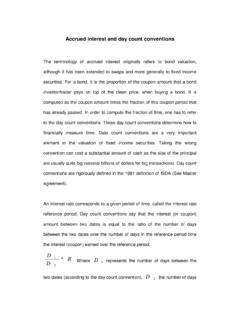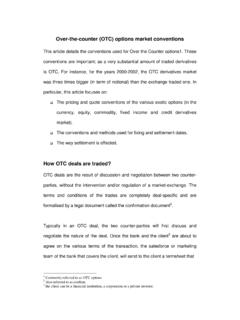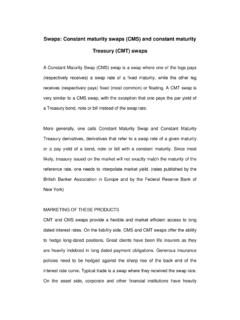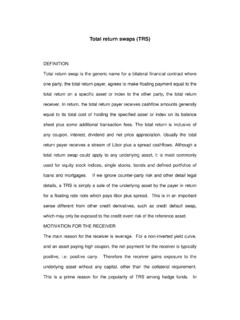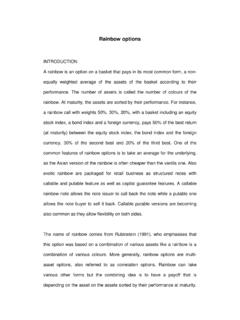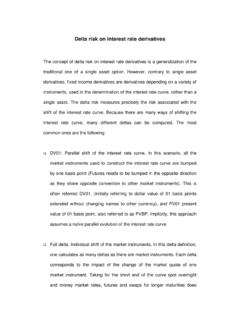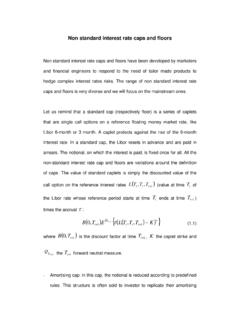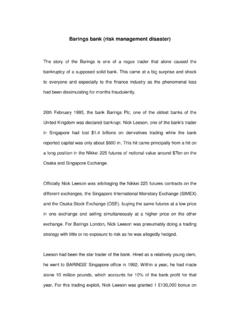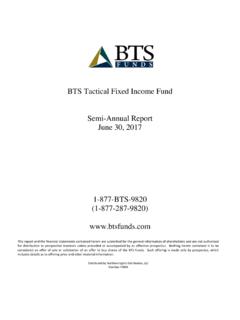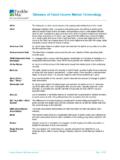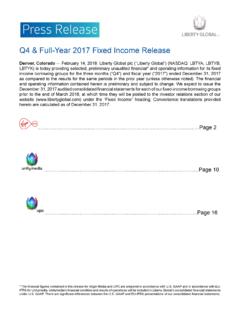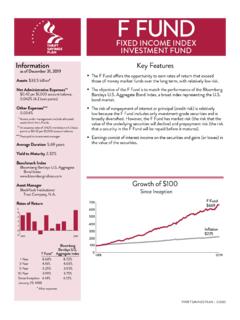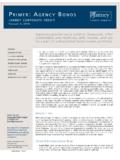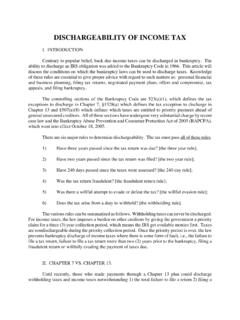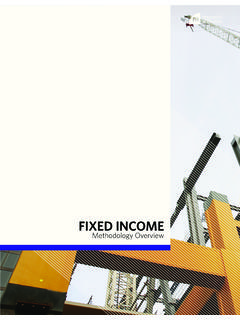Transcription of Fixed income markets (overview) - Eric Benhamou
1 Fixed income markets (overview) Fixed income markets encompass all interest rate financial instruments, like a bond, money market instrument, swaps, caps floors, swaptions and more generally any interest rates derivatives. Investment banks often split their trading activity between equity, foreign exchange, Fixed income , commodity markets as they are all very different markets . 1. markets AND INSTRUMENTS The original motivation for the Fixed income market was to enable the borrowing and lending of money via debt financing with instruments like bonds, Futures and FRAs (Forward Rate Agreement). However, many other instruments have been developed to allow flexible hedging of debt as well as investment and speculation in these markets : swaps, but also options, like caps, floors, swaptions and various more exotic instruments.
2 Usually, one divides the Fixed income markets into: Simple instruments, mainly swaps and bonds Exotic interest rate derivatives, such as exotic caps, and swaptions Credit derivatives as a by-product of Fixed income markets , as the credit protection concerns directly bonds and debt instruments. SIMPLE INTEREST RATE INSTRUMENTS The simple instruments1 also referred to as the vanilla products of the Fixed income markets are generally liquid instruments, well known by the various Fixed income market participants and whose pricing is relatively easy. The list of such vanilla instruments includes: Money market, which provides the rate at which banks can lend or borrow money, plus or minus a spread depending on their credit rating.
3 Bonds: these can be either government, agency and sovereign bonds, or corporate bonds. Bonds can have various exotic features that makes them not as vanilla as the school case bonds2. The (liquid) bond market provides a cheap, efficient way for hedging and speculating on interest rates. For instance, in year 2002, the US treasuries market represented $3 trillion of outstanding debt, with an average daily trading volume of $300 billion (source ISDA). Futures: there are various types of Futures, such as Eurodollar Futures: cover short term (between a few days to three months time for the first contract, depending on when the first IMM3 date occurs) up to medium term contracts, which allows to agree on a future deposit rate.
4 Bond Futures: a Futures contract on a theoretical bond also called notional bond. Swap: in its vanilla form, this refers to the single-currency market of swaping Fixed against floating and vice versa. Swaps are very general structures and can recover many different products. For instance, the 1 although their contract s details can in certain case be not that simple. 2 Like various right to call or put the bond, like bond paying an inflation index or any non standard index. 3 IMM stands for International Money Market swap can have amortising notional, as opposed to bullet notional (standard swap), compounding or averaging fixings, can be between different currencies (cross currency swaps), or between two different floating rates (basis swaps).
5 The fixing of the Libor in the swap can be paid immediately (in-arrear swap). The floating rate paid can be a constant maturity swap (CMS, CMT swaps). Forward Rate Agreement (FRA): these are forward contracts on a specific rate. Asset swap: allows to swap a given bond against the stream of Libor payment plus a spread. It is the spread over Libor that is actually quoted in an asset swap. Over the last few years, we have seen an important development of electronic trading platforms for these products. Most of these products are nowadays quoted electronically on various computerised exchanges. OVERVIEW OF INTEREST RATE DERIVATES The zoology of interest rates derivatives has exploded over the last few years as a result of a greater sophistication of the client needs and interest rates hedging technology.
6 Vanilla or very-close-to-vanilla products are: Caps and Floors: which are a strip of simple options (caplets or floorlets) to cap or floor a given interest rate, often a Libor rate. European Swaptions, which are options to enter in a receiver or payer (depending on the type) swap. Bermudan Swaptions. These options which gives the right at various exercise date to enter in a payer or receiver swap (depending on the type of swaption) have progressively become more and more vanilla as their traded volume have substantially increased while simultaneously, the pricing technology have become more and more standard. Compared to standard vanilla options, pricing models have to account for the various conditional forward volatility.
7 Although, one factor mean reverting models may make the job through the term structure of mean reversion, two factors models would provide very different hedging strategy. Bermudan swaption can be thought as the most European option plus a switch option to exchange this most expensive European swaption with other possible swaptions. Pseudo vanilla swaps, such as Quanto swap where the Libor rate is denominated in another currency than the one paid, like for instance a Euro denominated swap on the US Dollar Libor rate. Quanto swap depends on the forward correlation. Innovative way of modelling the dependence between the forward FX and the interest rates includes the use of copula. CMS, CMT swap, where the floating rate is a swap rate or treasury rate of constant maturity.
8 It is easy to show that a portfolio of cash settled swaption can statistically replicate a CMS swap. For physically settled swaption, CMS swap can be also replicated by modelling the annuity of the swap as a function of the swap rate. This is equivalent to make a one factor approximation. inverse floater swap, where one pays a Fixed rate minus Libor; often callable. trigger swap, that pays only if a specific rate hits the barrier, or a reference index, such as an equity stock index or a commodity index, has reached some level (knock-in version). Alternatively, the swap can be cancelled if the reference index hits the knockout level. The risk of this strategy lies in the skew of the smile at the barrier level.
9 Easy modelling of this skew includes shifted lognormal models with stochastic volatility, mapping models between normal and lognormal very equivalent to shifted lognormal models, CEV models with stochastic volatility (for which one can obtain approximation with closed form solution). Combination of the above, like triggered quanto CMS swap ..etc. Exotic instruments includes the following: Exotic swaps like: range floater, which pays if the floating rate is within a range; also referred to as a range accrual or accumulator note. Exotic range accrual include callable range accrual where the option issuer has the right to cancel the structure at certain dates, but also double-up range accrual where the issuer can double the size.
10 Other variation includes triggered range accrual where the structure is activated if a reference asset has reached some specified level. This third party asset can be commodity or equity, making it a cross asset or hybrid product. This product includes a smile risk at the barrier in their simple version and in the case of triggered range accrual, an additional correlation risk. index amortizer swap, which pays on a notional that amortizes according to the performance of a given rate. This product is much more complex than a swap with a scheduled deterministic amortizing notional as the amortization of the notional in this structure is not known in advance and depends strongly on the full term structure of interest rate and their correlation.
